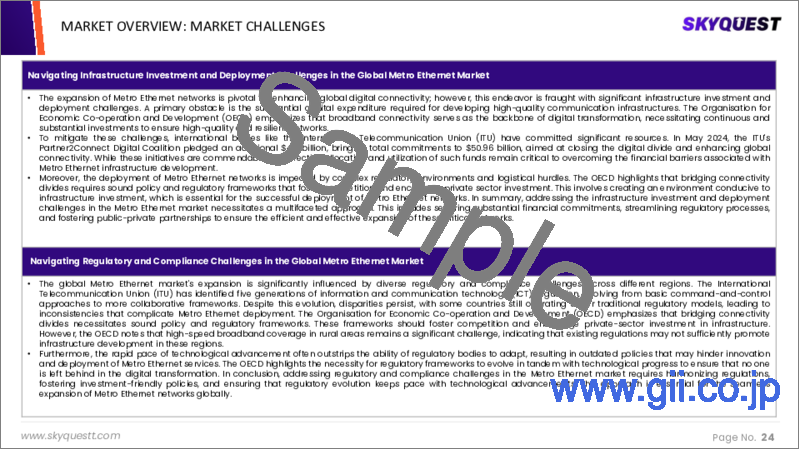|
|
市場調査レポート
商品コード
1623960
メトロイーサネット市場規模、シェア、成長分析、サービスタイプ別、事業規模別、オファリング別、帯域幅範囲別、用途別、エンドユーザー別、地域別-産業予測、2025~2032年Metro Ethernet Market Size, Share, Growth Analysis, By Service Type, By Business Size, By Services Offered, By Bandwidth Range, By Application, By End Users, By Region - Industry Forecast 2025-2032 |
||||||
|
|||||||
| メトロイーサネット市場規模、シェア、成長分析、サービスタイプ別、事業規模別、オファリング別、帯域幅範囲別、用途別、エンドユーザー別、地域別-産業予測、2025~2032年 |
|
出版日: 2025年01月01日
発行: SkyQuest
ページ情報: 英文 157 Pages
納期: 3~5営業日
|
全表示
- 概要
- 目次
メトロイーサネットの世界市場規模は2023年に291億米ドルとなり、予測期間(2025~2032年)のCAGRは5.8%で、2024年の307億9,000万米ドルから2032年には483億4,000万米ドルに成長する展望です。
メトロイーサネットは、メトロポリタンエリアネットワーク(MAN)のポイント・ツー・ポイント接続とマルチポイント接続の両方を提供する重要なイーサネット伝送ネットワークとして登場しました。もともとはローカルエリアネットワーク(LAN)技術として開発されたイーサネットは、現在では従来の低速ワイドエリアネットワーク(WAN)ソリューションに取って代わるまでに進化しています。ビジネス、住宅、モバイルユーザーの間でイーサネットサービスの採用が増加しているのは、その手頃な価格、柔軟性、使いやすさに起因しています。高速で信頼性の高い接続性に対する需要の高まりは、現代の通信インフラにおけるメトロイーサネットの役割をさらに際立たせ、費用対効果の高い方法でネットワークのパフォーマンスと効率性を向上させたいと考えている様々な加入者に好まれる選択肢となっています。
目次
イントロダクション
- 調査の目的
- 調査範囲
- 定義
調査手法
- 情報調達
- 二次データと一次データの方法
- 市場規模予測
- 市場の前提条件と制限
エグゼクティブサマリー
- 世界市場の展望
- 供給と需要の動向分析
- セグメント別機会分析
市場力学と展望
- 市場概要
- 市場規模
- 市場力学
- 促進要因と機会
- 抑制要因と課題
- ポーターの分析
主要市場の考察
- 重要成功要因
- 競合の程度
- 主要投資機会
- 市場エコシステム
- 市場の魅力指数(2024年)
- PESTEL分析
- マクロ経済指標
- バリューチェーン分析
- 価格分析
- 技術の進歩
- 規制分析
メトロイーサネット市場規模:サービスタイプ別&CAGR(2025~2032年)
- 市場概要
- 専用イーサネット
- ポイントツーマルチポイント
- ポイントツーポイント
- スイッチドイーサネット
- 仮想プライベートLANサービス
- 仮想プライベート有線サービス
メトロイーサネット市場規模:企業規模別&CAGR(2025~2032年)
- 市場概要
- 大企業
- 中小企業
メトロイーサネット市場規模:オファリング別&CAGR(2025~2032年)
- 市場概要
- コンサルティングサービス
- 設置とサポート
- メンテナンスサービス
- アップグレードサービス
- テクニカルサポート
- オンサイトサポート
- リモートサポート
メトロイーサネット市場規模:帯域幅範囲別&CAGR(2025~2032年)
- 市場概要
- 100 Mbps以下
- 100 Mbps~1 Gbps
- 1Gbps以上
メトロイーサネット市場規模:用途別&CAGR(2025~2032年)
- 市場概要
- データセンター相互接続
- クロスコネクトサービス
- 建物間の接続
- 専用回線サービス
- エンタープライズ接続
- 広域ネットワーク
- クラウドネットワーキングサービス
- オフィス間の接続
メトロイーサネット市場規模:エンドユーザー別&CAGR(2025~2032年)
- 市場概要
- BFSI
- 政府と防衛
- 医療提供者
- 小売
- 通信とITサービス
メトロイーサネット市場規模&CAGR(2025~2032年)
- 北米
- 米国
- カナダ
- 欧州
- ドイツ
- スペイン
- フランス
- 英国
- イタリア
- その他の欧州
- アジア太平洋
- 中国
- インド
- 日本
- 韓国
- その他のアジア太平洋
- ラテンアメリカ
- ブラジル
- その他のラテンアメリカ
- 中東・アフリカ
- GCC諸国
- 南アフリカ
- その他の中東・アフリカ
競合情報
- 上位5社の比較
- 主要企業の市場ポジショニング(2024年)
- 主要市場企業が採用した戦略
- 市場の最近の動向
- 企業の市場シェア分析(2024年)
- 主要企業の企業プロファイル
- 製品ポートフォリオ分析
- セグメント別シェア分析
- 収益の前年比比較(2022~2024年)
主要企業プロファイル
- AT&T Inc.(米国)
- Lumen Technologies, Inc.(米国)
- Verizon Communications Inc.(米国)
- Comcast Corporation(米国)
- Charter Communications, Inc.(米国)
- Cox Communications, Inc.(米国)
- Vodafone Group Plc(英国)
- Orange S.A.(フランス)
- Deutsche Telekom AG(ドイツ)
- BT Group plc(英国)
- NTT Communications Corporation(日本)
- China Telecom Corporation Limited(中国)
- China Mobile Limited(中国)
- Telstra Corporation Limited(オーストラリア)
- KDDI Corporation(日本)
- SK Telecom Co., Ltd.(韓国)
- Rogers Communications Inc.(カナダ)
- Bell Canada Enterprises(BCE)Inc.(カナダ)
- Telefonica, S.A.(スペイン)
- Swisscom AG(スイス)
結論と推奨事項
Global Metro Ethernet Market size was valued at USD 29.1 billion in 2023 and is poised to grow from USD 30.79 billion in 2024 to USD 48.34 billion by 2032, growing at a CAGR of 5.8% during the forecast period (2025-2032).
Metro Ethernet has emerged as a vital Ethernet transport network, offering both point-to-point and multipoint connectivity across metropolitan area networks (MAN). Originally developed as a local area network (LAN) technology, Ethernet has now evolved to effectively replace traditional low-speed wide-area network (WAN) solutions. The increasing adoption of Ethernet services among business, residential, and mobile users can be attributed to their affordability, flexibility, and ease of use. The growing demand for high-speed, reliable connectivity further underscores Metro Ethernet's role in modern communication infrastructure, making it a preferred choice for a diverse range of subscribers looking to enhance their network performance and efficiency in a cost-effective manner.
Top-down and bottom-up approaches were used to estimate and validate the size of the Global Metro Ethernet market and to estimate the size of various other dependent submarkets. The research methodology used to estimate the market size includes the following details: The key players in the market were identified through secondary research, and their market shares in the respective regions were determined through primary and secondary research. This entire procedure includes the study of the annual and financial reports of the top market players and extensive interviews for key insights from industry leaders such as CEOs, VPs, directors, and marketing executives. All percentage shares split, and breakdowns were determined using secondary sources and verified through Primary sources. All possible parameters that affect the markets covered in this research study have been accounted for, viewed in extensive detail, verified through primary research, and analyzed to get the final quantitative and qualitative data.
Global Metro Ethernet Market Segmental Analysis
Global Metro Ethernet Market is segmented by Service Type, Business Size, Services Offered, Bandwidth Range, Application, End Users and region. Based on Service Type, the market is segmented into Dedicated Ethernet and Switched Ethernet. Based on Business Size, the market is segmented into Large Enterprises and SMEs. Based on Services Offered, the market is segmented into Consulting Services, Installation and Support and Technical Support. Based on Bandwidth Range, the market is segmented into Below 100 Mbps, 100 Mbps to 1 Gbps, and Above 1 Gbps. Based on Application, the market is segmented into Data Center Interconnection, Private Line Services and Wide Area Network. Based on End Users, the market is segmented into BFSI, Government and Defense, Healthcare Providers, Retail and Telecom and IT Services. Based on region, the market is segmented into North America, Europe, Asia Pacific, Latin America and Middle East & Africa.
Driver of the Global Metro Ethernet Market
The Global Metro Ethernet market is experiencing significant growth driven by the need for businesses and organizations to effortlessly connect their branches and employees within a cohesive network. This ease of connectivity eliminates the complexities of transferring signals or technologies across various locations. Additionally, a surge in services like VoIP (Voice over Internet Protocol), video transmission over the Internet, and secure data transfer methods is propelling market expansion. The increasing appetite for on-demand content delivery services further enhances growth, as Metro Ethernet also offers consumer services, making it an ideal solution for delivering on-demand content efficiently.
Restraints in the Global Metro Ethernet Market
The growth of the Global Metro Ethernet market is expected to face several challenges primarily due to the rising competition among telecom providers and elevated customer bargaining power. These factors can significantly hinder market expansion, as telecom companies must navigate complex customer requirements while managing fierce competition with their peers. Meeting the specific needs of networks while differentiating their offerings becomes a formidable task for service providers. Consequently, the interplay of these elements poses a substantial constraint on the overall development of the Metro Ethernet sector, requiring companies to strategize effectively to overcome these market hurdles.
Market Trends of the Global Metro Ethernet Market
The Global Metro Ethernet market is experiencing a robust upward trend driven by escalating data traffic demands fueled by the proliferation of high-definition video content and cloud-based applications. As consumers and businesses increasingly rely on rapid internet access for streaming, remote work, and data-intensive operations, the market is witnessing a shift from 1 GbE to advanced 100 GbE ports and connections. This transformation is not only enhancing service capabilities but also creating opportunities for metro network providers to cater to both residential and corporate sectors. Consequently, this surge in demand is positioning Metro Ethernet as a critical enabler of modern digital connectivity solutions worldwide.
Table of Contents
Introduction
- Objectives of the Study
- Scope of the Report
- Definitions
Research Methodology
- Information Procurement
- Secondary & Primary Data Methods
- Market Size Estimation
- Market Assumptions & Limitations
Executive Summary
- Global Market Outlook
- Supply & Demand Trend Analysis
- Segmental Opportunity Analysis
Market Dynamics & Outlook
- Market Overview
- Market Size
- Market Dynamics
- Drivers & Opportunities
- Restraints & Challenges
- Porters Analysis
- Competitive rivalry
- Threat of substitute
- Bargaining power of buyers
- Threat of new entrants
- Bargaining power of suppliers
Key Market Insights
- Key Success Factors
- Degree of Competition
- Top Investment Pockets
- Market Ecosystem
- Market Attractiveness Index, 2024
- PESTEL Analysis
- Macro-Economic Indicators
- Value Chain Analysis
- Pricing Analysis
- Technological Advancement
- Regulatory Analysis
Global Metro Ethernet Market Size by Service Type & CAGR (2025-2032)
- Market Overview
- Dedicated Ethernet
- Point-To-Multipoint
- Point-To-Point
- Switched Ethernet
- Virtual Private LAN Service
- Virtual Private Wire Service
Global Metro Ethernet Market Size by Business Size & CAGR (2025-2032)
- Market Overview
- Large Enterprises
- SMEs
Global Metro Ethernet Market Size by Services Offered & CAGR (2025-2032)
- Market Overview
- Consulting Services
- Installation and Support
- Maintenance Services
- Upgrade Services
- Technical Support
- Onsite Support
- Remote Support
Global Metro Ethernet Market Size by Bandwidth Range & CAGR (2025-2032)
- Market Overview
- Below 100 Mbps
- 100 Mbps to 1 Gbps
- Above 1 Gbps
Global Metro Ethernet Market Size by Application & CAGR (2025-2032)
- Market Overview
- Data Center Interconnection
- Cross-Connect Services
- Inter-Building Connectivity
- Private Line Services
- Enterprise Connectivity
- Wide Area Network
- Cloud Networking Services
- Interoffice Connectivity
Global Metro Ethernet Market Size by End Users & CAGR (2025-2032)
- Market Overview
- BFSI
- Government and Defense
- Healthcare Providers
- Retail
- Telecom and IT Services
Global Metro Ethernet Market Size & CAGR (2025-2032)
- North America (Service Type, Business Size, Services Offered, Bandwidth Range, Application, End Users)
- US
- Canada
- Europe (Service Type, Business Size, Services Offered, Bandwidth Range, Application, End Users)
- Germany
- Spain
- France
- UK
- Italy
- Rest of Europe
- Asia Pacific (Service Type, Business Size, Services Offered, Bandwidth Range, Application, End Users)
- China
- India
- Japan
- South Korea
- Rest of Asia-Pacific
- Latin America (Service Type, Business Size, Services Offered, Bandwidth Range, Application, End Users)
- Brazil
- Rest of Latin America
- Middle East & Africa (Service Type, Business Size, Services Offered, Bandwidth Range, Application, End Users)
- GCC Countries
- South Africa
- Rest of Middle East & Africa
Competitive Intelligence
- Top 5 Player Comparison
- Market Positioning of Key Players, 2024
- Strategies Adopted by Key Market Players
- Recent Developments in the Market
- Company Market Share Analysis, 2024
- Company Profiles of All Key Players
- Company Details
- Product Portfolio Analysis
- Company's Segmental Share Analysis
- Revenue Y-O-Y Comparison (2022-2024)
Key Company Profiles
- AT&T Inc. (United States)
- Company Overview
- Business Segment Overview
- Financial Updates
- Key Developments
- Lumen Technologies, Inc. (United States)
- Company Overview
- Business Segment Overview
- Financial Updates
- Key Developments
- Verizon Communications Inc. (United States)
- Company Overview
- Business Segment Overview
- Financial Updates
- Key Developments
- Comcast Corporation (United States)
- Company Overview
- Business Segment Overview
- Financial Updates
- Key Developments
- Charter Communications, Inc. (United States)
- Company Overview
- Business Segment Overview
- Financial Updates
- Key Developments
- Cox Communications, Inc. (United States)
- Company Overview
- Business Segment Overview
- Financial Updates
- Key Developments
- Vodafone Group Plc (United Kingdom)
- Company Overview
- Business Segment Overview
- Financial Updates
- Key Developments
- Orange S.A. (France)
- Company Overview
- Business Segment Overview
- Financial Updates
- Key Developments
- Deutsche Telekom AG (Germany)
- Company Overview
- Business Segment Overview
- Financial Updates
- Key Developments
- BT Group plc (United Kingdom)
- Company Overview
- Business Segment Overview
- Financial Updates
- Key Developments
- NTT Communications Corporation (Japan)
- Company Overview
- Business Segment Overview
- Financial Updates
- Key Developments
- China Telecom Corporation Limited (China)
- Company Overview
- Business Segment Overview
- Financial Updates
- Key Developments
- China Mobile Limited (China)
- Company Overview
- Business Segment Overview
- Financial Updates
- Key Developments
- Telstra Corporation Limited (Australia)
- Company Overview
- Business Segment Overview
- Financial Updates
- Key Developments
- KDDI Corporation (Japan)
- Company Overview
- Business Segment Overview
- Financial Updates
- Key Developments
- SK Telecom Co., Ltd. (South Korea)
- Company Overview
- Business Segment Overview
- Financial Updates
- Key Developments
- Rogers Communications Inc. (Canada)
- Company Overview
- Business Segment Overview
- Financial Updates
- Key Developments
- Bell Canada Enterprises (BCE) Inc. (Canada)
- Company Overview
- Business Segment Overview
- Financial Updates
- Key Developments
- Telefonica, S.A. (Spain)
- Company Overview
- Business Segment Overview
- Financial Updates
- Key Developments
- Swisscom AG (Switzerland)
- Company Overview
- Business Segment Overview
- Financial Updates
- Key Developments






